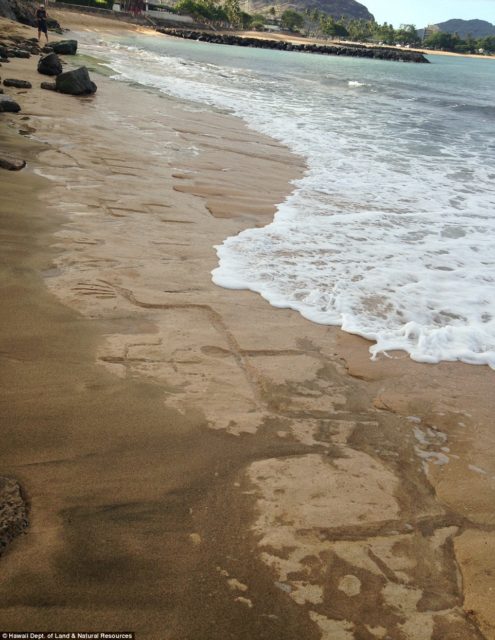Hawaii’s shifting sands reveal petroglyphs that may have been carved by aboriginal settlers
Hawaii’s shifting sands reveal petroglyphs that may have been carved by aboriginal settlers
Hawaii’s shorelines are famous surf spots that are world-renowned. But more than just white waters and barrels, breaking waves produced, but washing away the sands to unveil the outlines of ancient forms that were carved into the bedrock.
Americans came across a number of petrogyphs on holiday on Oahu Island, engravings of men in the sandstone, believed to have been made by early native dwellers of the islands.
Specialists claim that the engravings found on the shoreline of the Wai’ anae shore line, may be hundreds of years old, dating back to the first European settlers who arrived in the late 1700s on the islands.
The largest of the glyphs depicts a nearly-life-size person with articulated fingers and toes.
The series of petrogyphs extend over 18 meters (16 ft) of beach and have been exposed by waves washing away the sand. Yet the incoming tide partly covers the shapes with the coastlines unsteady sands.

They might have been uncovered, and covered several times since they were engraved, just waiting to be found.
The Hawaiian islands were believed to have been inhabited for millions of years subsequent to volcanic activity. Anthropologists think the chain was first colonized by native individuals from Polynesia.
These seafarers are believed to have voyaged across the Pacific Ocean from island to island, before settling on the volcanic island as early as 300 CE.
Archaeologists with the US Army visited the site to research the petrogyphs along with Hawaii’s Department of Land and Natural Resources, who calculate at least 17 shapes engraved into the beach.
They state these engravings are much larger than others they have seen, and display more detail, with several of the petroglyphs comprising fingers on their hands. This is the first site with petrogyphs directly located on the shoreline.
Archaeologists are coming up with a plan to preserve, and protect this site due to its cultural significance. Many of the petrogyphs are about a foot tall, yet these measure up to 4 or 5 feet from head to toe.